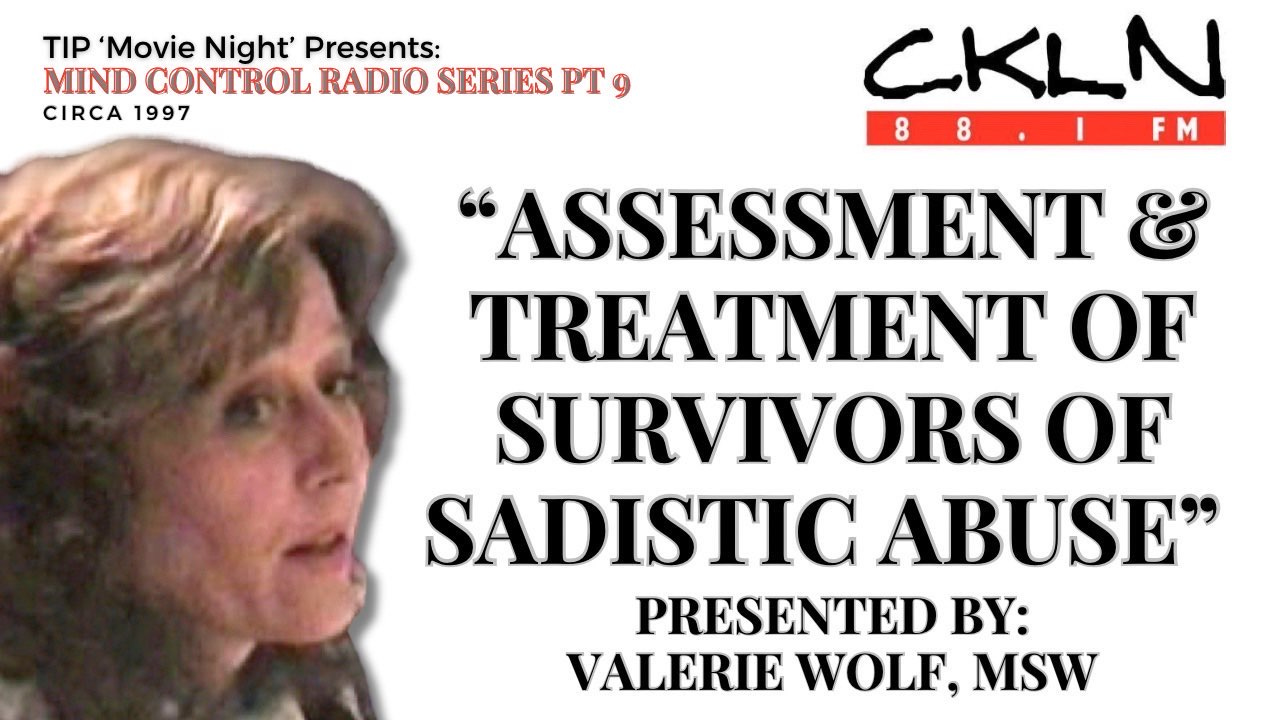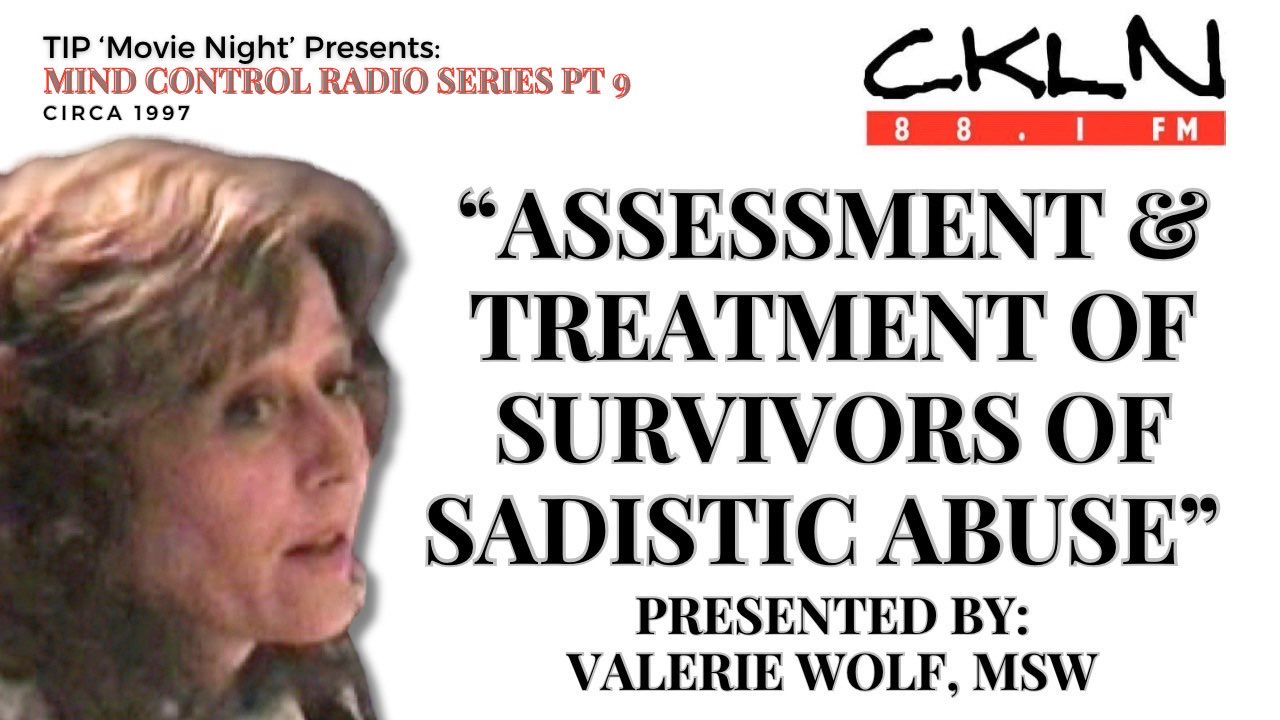TIP Movie Night | CKLN MC Radio Series 9: Valerie Wolf - Assessment & Treatment of Survivors of Sadistic Abuse
Overview, Takeaways, and Afterthoughts
Overview:
This comprehensive presentation by Valerie Wolf, delivered at the Believe the Children Conference in 1997, offers a deeply insightful and methodical approach to the assessment and treatment of survivors of sadistic ritual abuse (SRA) and mind control, particularly those subjected to CIA-sponsored experiments and trauma. Drawing from her extensive clinical experience with survivors such as Claudia Mullen, Wolf elucidates the complex psychological, physiological, and neurological consequences of severe trauma, dissociation, and mind control programming.
Wolf’s therapeutic model is grounded in stage-oriented trauma treatment, emphasizing a structured process: ongoing assessment, safety and stabilization (which constitutes 80% of treatment), trauma metabolism (memory work), and trauma resolution. She stresses the importance of individualized, client-directed therapy, where survivors guide the pace and focus of treatment, rather than the therapist imposing a rigid structure. This approach respects the unique and often non-linear healing journeys of survivors.
Key assessment areas include evaluating current symptoms, the client’s relational patterns and attachment capabilities, addiction and victimization histories, suicidal ideation and self-destructive behaviors, support networks, memory awareness, and physical symptoms such as distinctive body pain and sleep disturbances. Wolf underscores the necessity of understanding the survivor’s language, communication style, and the often symbolic or hypnotic nature of their expressions.
She provides an intricate explanation of dissociative identity disorder (DID) and its variants (such as DDNOS), emphasizing the role of the core birth personality and the function of alternate identities (or “alters”) as protectors with assigned “jobs.” Contrary to misconceptions, even alters exhibiting harmful behavior are seen as performing protective roles, highlighting a compassionate, reframed perspective essential for healing. The therapeutic goal includes establishing an internal “safe place” or “secret place” for containment, healing, and processing traumatic memories, equipped with symbolic features such as walls of protective water, healing pools, nurseries, and infirmaries for vulnerable parts.
Wolf details numerous trauma-related programs embedded in survivors’ memories, including hypnotic post-suggestions, physical and sensory programming, and specific mind control mechanisms like “switching places,” “black holes,” “spin programs,” and “mirror programs.” These are addressed with concrete, literal interventions such as “cleaning off” electrodes, filling black holes, switching off harmful programs, and dismantling symbolic traps in the survivors’ internal world.
She emphasizes managing therapist transference and countertransference with patience, self-awareness, and peer support, recognizing the emotional challenges inherent in working with such a complex population. Boundaries and planned, extended therapy sessions are critical for stability and progress.
Throughout, Wolf highlights the importance of empowering survivors by fostering responsibility for their own safety and choices, countering shame, guilt, and internalized blame—common tools of manipulation used by perpetrators. The treatment process acknowledges the spiritual and existential dimensions of trauma, often encountered in survivors’ struggles with alienation from God and self.
Takeaways:
Healing Mind Control Survivors Requires a Compassionate, Client-Led Approach
Survivors possess an innate wisdom about their healing process. Therapists must prioritize listening, respect client autonomy, and avoid imposing structured agendas. This fosters trust, attachment, and empowerment vital for recovery.
Safety and Stabilization Are the Cornerstones of Effective Treatment
Before engaging in memory work, survivors must develop robust internal and external safety structures. The majority of therapy time should be devoted to stabilization to prevent retraumatization and ensure sustainable progress.
Mind Control Programming Is Embedded in Memory and Behavior, Not Abstract Codes
Therapeutic efforts should focus on uncovering and resolving the concrete traumatic memories underlying programming rather than abstract decoding or confrontational methods, which risk dehumanizing the client.
Therapy Must Work With the Internal System as a Whole
Recognizing alters as protectors with specific jobs reframes challenging behaviors as survival strategies rather than pathology. This perspective enables effective collaboration with all parts of the system for healing and integration.
Post-Hypnotic Suggestions and Compulsive Behaviors Can Be Countered Through Repetition and Affirmation
Consistent, calm verbal counter-programming is effective in reducing self-destructive impulses and embedded commands, restoring survivors’ sense of choice and control.
Therapists Must Manage Their Own Emotional Responses to Avoid Burnout and Maintain Objectivity
Peer support and self-care are essential to address countertransference, vicarious trauma, and emotional exhaustion inherent in working with such complex and disturbing material.
Memory Work Must Be Carefully Planned and Conducted Within a Safe Therapeutic Framework
Only when clients demonstrate sufficient stabilization and containment can trauma memories be safely processed. The goal is not catharsis alone but reclaiming information that undoes programming and restores agency.
Healing Is a Multi-Dimensional Process Involving Body, Mind, and Spirit
Addressing somatic symptoms, emotional regulation, relational patterns, and spiritual wounds collectively supports comprehensive recovery and reintegration of the self.
Therapeutic Progress Is Non-Linear and Requires Patience and Flexibility
Clients may experience setbacks, shifts in parts, and complex emotional responses. Therapists must adapt and follow the client’s pace, allowing for gradual rebuilding of self-coherence.
The Reality of Mind Control Abuse Is Concrete and Literal—Therapy Must Respect That
Imagery such as matrices, switching places, and safe places are not metaphorical but experienced realities for survivors. Therapists must validate these experiences and work within their frameworks rather than dismiss or reinterpret them.
Afterthoughts:
Valerie Wolf’s profound work reveals the extraordinary resilience of survivors of mind control and sadistic abuse. Through compassionate, client-led therapy grounded in solid trauma principles and deep understanding of dissociative systems, healing is not only possible but demonstrably effective.
Her approach underscores that survivors hold the keys to their own recovery, and with skilled therapeutic support, they can reclaim autonomy, safety, and wholeness from even the most devastating programming. The journey is complex and requires patience, creativity, and unwavering respect for the client’s inner world. Yet, as the evidence shows, recovery from mind control trauma is a powerful testament to human strength and the transformative power of healing relationships.
Ultimately, Valerie Wolf’s presentation inspires hope by offering a compassionate, detailed, and practical framework for clinicians and survivors alike, demonstrating that despite the profound damage inflicted by sadistic abuse and mind control, recovery is attainable through careful, respectful, and informed therapeutic work.
Previous CKLN Mind Control Radio Series:
P2 - Dr. Colin Ross Mind Control Interview with Wayne Morris
P3 - Claudia Mullen & Radiation Hearings Mind Control Testimony
P4 - Interview with US Government Abductee Ronald Howard Cohen
P5 - An Overview of Ritual Abuse, Mind Control & Dissociation
P6 - "The History of Mind Control" With Alan Scheflin (1995)
P7 - Interview with Valerie Wolf, Claudia Mullen & Chris Ebner



